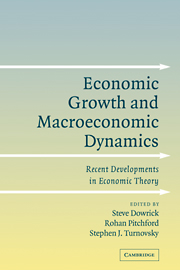Book contents
- Frontmatter
- Contents
- Preface
- Contributors
- PART ONE TOPICS IN GROWTH THEORY
- PART TWO STATISTICAL ISSUES IN GROWTH AND DYNAMICS
- PART THREE DYNAMIC ISSUES IN INTERNATIONAL ECONOMICS
- 6 Dynamic Trade Creation
- 7 Substitutability of Capital, Investment Costs, and Foreign Aid
- 8 Microchurning with Smooth Macro Growth: Two Examples
- Index
8 - Microchurning with Smooth Macro Growth: Two Examples
Published online by Cambridge University Press: 31 October 2009
- Frontmatter
- Contents
- Preface
- Contributors
- PART ONE TOPICS IN GROWTH THEORY
- PART TWO STATISTICAL ISSUES IN GROWTH AND DYNAMICS
- PART THREE DYNAMIC ISSUES IN INTERNATIONAL ECONOMICS
- 6 Dynamic Trade Creation
- 7 Substitutability of Capital, Investment Costs, and Foreign Aid
- 8 Microchurning with Smooth Macro Growth: Two Examples
- Index
Summary
Macroeconomic models of economies in the growth process are most often highly aggregated. There is no doubt that many variations at the detailed microeconomic level can yield the same overall macrolevels of growth, perhaps remaining fairly constant at high levels for years if not decades. However, the smooth aggregate levels may disguise rather interesting churning activity at the microlevel, with compositional changes that are not accidental and may, indeed, help to maintain high overall levels of growth. Here I wish mainly to consider two examples of this phenomenon, one focused on international trade and the other on technology.
INTERNATIONAL TRADE AND CHURNING AT THE MICROLEVEL
By definition, a country that engages in international trade forsakes the kind of balanced growth associated with autarky, with local production responding to local demand. However, in simple textbook models of international trade that limit production and consumption to two commodities, it is possible to consider a balanced expansion in the composition of a country's production levels, with aggregate growth rates matched by those in each sector. What is missing in this account is the potential of international trade to allow (or force) a country to produce only a narrow range of products for the world market while consuming a wide variety of commodities, some requiring higher capital–labor ratios than found in home production and others that would utilize more labor-intensive techniques than endowment ratios available at home. Furthermore, economic growth usually entails rising levels of per capita income, often accompanied by net investment (either from local savings or from foreign sources) and perhaps by improvements in technology.
- Type
- Chapter
- Information
- Economic Growth and Macroeconomic DynamicsRecent Developments in Economic Theory, pp. 171 - 178Publisher: Cambridge University PressPrint publication year: 2004
- 2
- Cited by



